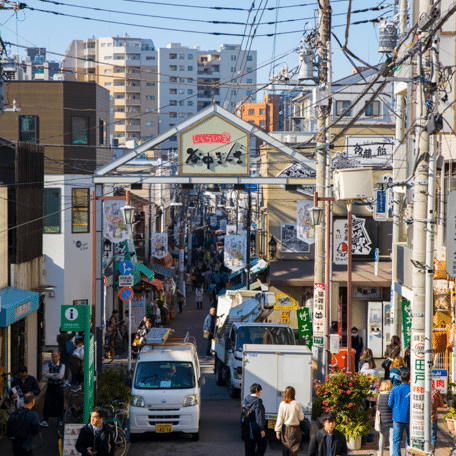Yakitori vs. Kushiage: A Guide to Japan’s Favorite Skewered Foods
May 16, 2022
BY Luna Cullis

A staple of Japanese Izakaya culture and the perfect companion to an ice cold nama biru (draft beer), the infamous yakitori (grilled chicken skewers), and its perhaps lesser known cousin, kushiage (skewers of deep fried meat, seafood, or vegetables) are an essential part of Japanese cuisine.
Each charcoal grilled yakitori can be enjoyed slathered in tare (soy sauce based glaze) or simply coated in salt (shio), and when you start craving something with a little more bite, turn your attention to some crispy panko (Japanese breadcrumbs) coated kushiage. Both equally full of flavor and dangerously moreish, these seemingly dainty skewers will lead you down a slippery slope as you try a never-ending variety of meat, vegetables, and seafood – you won’t want to stop!
We dissect why yakitori and kushiage are so crucial to Japanese social dining culture and break down our guide to all the skewers you have to try when you’re next in Japan.

Photo by Magic Mary on Unsplash
Grilled to perfection
Perfectly seasoned and individually grilled, each yakitori has its own unique flavor, texture and look. Utilizing almost every part of the chicken from head to toe, you can keep it simple with some momo (thigh meat) or if you’re feeling especially brave, why not go for the deliciously crunchy nankotsu (chicken cartilage)?
Small cuts of meat are seasoned and arranged on sticks made from metal or bamboo, creating uniform skewers. Originally cooked on portable charcoal grills, the high heat point and strong flames of the charcoal allow the meat to cook quickly while ensuring the outer layer remains crisp and the meat retains its special smoky flavor.
Yakitori break down
Unsure of where to start with the infinite types of yakitori on offer? We’ve created a helpful guide to the essential types of yakitori to try, so you can order like a pro the next time you visit your local Izakaya.

Image credit: Wikimedia Commons
Momo もも
Classic and deliciously juicy, your safest bet is to go for the chicken thigh. Tender and smoky, chicken thigh yakitori is a favorite amongst all the locals.

Image credit: Wikimedia Commons
Tsukune つくね
Soft, minced chicken, often shaped into meatballs. Coated in a sweet soy based sauce, if you want to switch up the texture of your yakitori, this is the choice for you.

Image credit: Wikimedia Commons
Kawa 皮
Tired of eating meat all the time? Why not go for some chewy, crunchy chicken skin? Taken from the neck, this skewer is a must-try for anyone with a penchant for interesting textures.

Image credit: Wikimedia Commons
Tebasaki 手羽先
Everyone loves a chicken wing, but have you ever experienced the deep flavor and unbelievably crispy skin of a yakitori wing? Break through the crunchy outer layer and experience the juicy meat inside this popular skewer.

Image Credit: Wikimedia Commons
Leba / Hastu レバー / ハツ
For those most adventurous foodies, the chicken’s internal organs, namely the heart and liver, are sure to challenge even the broadest of palates. Subtle in flavor and surprisingly light, you won’t be disappointed by this traditional delicacy.

Image credit: Wikimedia Commons
It’s all about the fry
You might be more familiar with yakitori, but the crispier and perhaps even more addictive kushiage (also known as kushikatsu) is just as essential to the edible skewer landscape of Japan.
Each bite of golden fried perfection will leave you craving more, as the wide variety of flavors and textures make each kushiage unique in their own right. Skewered on bamboo sticks and dipped in egg, flour, and panko before being deep-fried in vegetable oil, kushiage has a fairly simple flavor that lets you enjoy the taste of the individual item.
Although you’ll want to try the traditional types including beef, pork, Japanese quail egg, asparagus, eggplant, lotus root, shrimp, and mackerel, there really aren’t many rules when it comes to these deep-fried skewers. If you can fry it, you can have it as kushiage. Round out the flavor with a dash of tonkatsu sauce (Japanese Worcestershire sauce) or simply eat them straight out of the frier – both are equally delicious.
Kushiage restaurants often offer a unique eating style as each skewer is dipped into a pot of sauce, shared amongst customers. Don’t forget the golden rule: no double-dipping! It can be seen as bad manners to dip your skewer more than once in the communal sauce pot so instead, customers are encouraged to use a slice of cabbage as a makeshift spoon to scoop up the sauce – handy right?

Image credit: Wikimedia Commons
Kushiage, the regional way
As with any traditional food, specific regions in Japan each have their own distinct way of preparing and eating kushiage, so if you truly want to experience kushiage as the locals do, make sure you explore each regional variety.
Osaka
Said to be the origin of kushiage, skewers in Osaka are prepared with a single food item on each stick rather than mixing things together. Whereas other regional styles include skewers with alternating items such as pork and onions, the Osaka variety is strictly limited to one ingredient.
Tokyo
The Kanto (area of eastern Japan) variety is traditionally made with diced pork rib and sliced onions or leeks. Coated with a thinner layer of panko, this kushiage can be enjoyed with a serving of mustard for those who like a slight kick with their food.
Nagoya
In Nagoya, kushiage is served with their local delicacy doteni (a dish made from dark miso paste, beef tendon and daikon radish). Diners are encouraged to dip their kushiage in this traditional stew, giving it the name, miso katsu.

Photo by Josh Wilburne on Unsplash
Yakitori like a local
Although there are many restaurants dedicated specifically to yakitori and kushiage, with set menus and an almost overwhelming array of skewers, the best way to experience these traditional foods is at a local Izakaya which you can usually find tucked away down an unassuming side street. Surrounded by the buzz of the local clientele, settle down with a couple of choice skewers, the perfect otsumami (snack eaten alongside alcohol) to accompany your favorite draft beer.
Neither a full meal, nor an appetizer, yakitori and kushiage are eaten in a style similar to Spanish tapas, designed for sharing and ordered over the course of several hours. So the next time you find yourself wandering down the streets of Japan, make sure to look out for the closest Izakaya and try their selection of yakitori or kushiage. What better way to get to know the local area and truly immerse yourself in Japanese culture?
Featured image: Pixabay
Discover more Japanese foods you need to try during your next trip on our Top 5 Foods Online Experience!
PIN THIS FOR LATER
Book your pocket wifi now to stay connected through your entire Japan Journey!

Be sure to get the JR Pass to make navigating Japan during your trip that much easier!

YOU MIGHT ALSO LIKE





